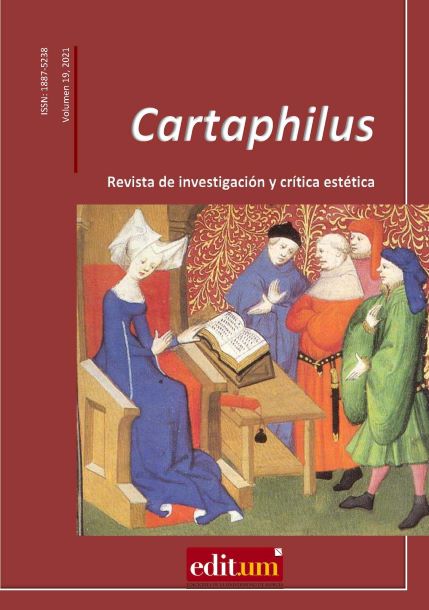Alessandro Piccolomini (1508-1579): an hypothesis of a "upside down world"
Abstract
In this article we consider the perspective that Piccolomini adopts in works with characters, interlocutors or recipients women, in order to propose a new interpretation that can overcome the vexata quaestio phylogy / misogyny, already deepened by critics, and to try to dispel doubts about the true nature of these writings. Through the analysis of La Raffaella and Oratione in lode delle donne, a distancing of the "Stordito" from rigid ideological positions emerges to use the ironic and playful perspective of the " upside down world", in which elements such as the overturning of vices take shape of women by virtue of social conventionality, stereotypes and the real world through the playful code.
Downloads
-
Abstract232
-
PDF (Español (España))544
References
Bajtin, M. (2003): La cultura popular en la Edad Media y en el Renacimiento. Madrid: Alianza Editonal.
Baldi, A. (2001): Tradizione e parodia in Alessandro Piccolomini. Lucca: Pacini Fazzi.
Bargagli, S. (1572): Dialoghi dei giochi che nelle vegghie sanesi si usano di fare. SIena: Bonetti.
Castiglione, B. (1970): Il libro del Cortegiano del conte Baldesar Castiglione. A cura di V. Cian. Firenze: Sansoni.
Coller, A. (2005): Bella Creanza and Female Destrezza: Women in Italian Renaissance Comedy. New York University.
Coller, A. (2006): “The Sienese Accademia degli Intronati and its female interlocutors”, The Italianist, XXVI n. 2, pagg. 223–246.
Cox, V. (2016): “Members, Muses, Mascots: Women and Italian Academies”, in The Italian Academies 1525-1700 Networks of Culture, Innovation and Dissent. Cambridge: Legenda, pagg. 132–169.
Gareffi, A. (1991): La scrittura e la festa. Teatro, festa e letteratura nella Firenze del Rinascimento. Bologna: Il Mulino.
King, L. M. (2014): “Rewiewed work: Parlour Games and the Public Life of Women in Renaissance Italy”, American Historical Rewiew. Buffalo, N.Y.: Oxford University Press, 119(5), pagg. 1792–93.
Mazzoni, S. (1998): L’Olimpico di Vicenza: un teatro e la sua ‘perpetua memoria’. Firenze: Le Lettere.
McClure, G. W. (2013): Parlour Games and the Public Life of Women in Renaissance Italy. Buffalo, N.Y.: University of Toronto Press.
Mucci, C. (2001): Il teatro delle streghe. Napoli: Liguori.
Piccolomini, A. (1545): “Orazione di M. Alessandro Piccolomini in lode delle medesime”, in De la nobiltà et eccellenza de le donne, della lingua francese nella italiana tradotto. Con una orazione di M. Alessandro Piccolomini in lode delle medesime. Venezia: Giolito.
Piccolomini, A. (2001): Dialogo della bella creanza delle donne. A cura di G. Alfano. Roma: Salerno editrice.
Piéjus, M.-F. (1980): “Venus bifrons: le double idéal féminin dans “La Raffaella” d’Alessandro Piccolomini”, in Guidi, J., Piéjus, M.-F., e Fiorato, A.-C. (a c. di) Images de la femme dans la littérature italienne de la Renaissance. Préjugés misogynes et aspirations nouvelles. Paris: Université de la Sorbonne Nouvelle, pagg. 81–167.
Pozzi, M. (1980): Trattati dell’amore del Cinquecento. Roma-Bari: Laterza.
Riccò, L. (2002): La ‘miniera’ accademica. Pedagogia, editoria, palcoscenico nella Siena del Cinquecento. Roma: Bulzoni.
Seragnoli, D. (1980): Il teatro a Siena nel Cinquecento. Progetto e Modello drammaturgico nell’Accademia degli Intronati. Roma: Bulzoni.
Testa, S. (2008): “Italian Academies 1530-1700. A Themed Collection Database. Un nuovo progetto sulle Accademie”, Bruniana & Campanelliana, XIV(1), pagg. 243–248.
Copyright (c) 2022 Gennaro Valentino

This work is licensed under a Creative Commons Attribution-NonCommercial-NoDerivatives 4.0 International License.
Works published in this journal are subject to the following terms:
1. The Servicio de Publicaciones of the University of Murcia (the publisher) reserves the copyright of the published works and encourages and allows their reuse under the usage licence indicated in point
© Servicio de Publicaciones, Universidad de Murcia, 2015
2. Works are published in the electronic edition of the journal under a Creative Commons Reconocimiento-NoComercial-SinObraDerivada 4.0 International licence (legal text). They may be copied, used, disseminated, transmitted and publicly displayed, on condition that: i) the author and original source of the publication are cited (journal, publisher and URL of the work); ii) the material is not used for commercial purposes; iii) the existence and specifications of this licence for use are mentioned.

3. Self-archiving conditions We allow and encourage authors to electronically disseminate the preprint versions (the pre-review version) and/or post print (the version that has been reviewed and accepted for publication) of their works before they are published as this encourages earlier circulation and dissemination and so a potential increase in their citation and impact in the academic community.




